In This Episode: From California, where I came to see and reflect on the End of Mission for the Cassini spacecraft — its so-called Grand Finale. This isn’t about the mission per se, but rather the thinking behind it, how that fits into True’s mission, and how that ties into this week’s Honorary Unsubscribe! In other words, The Bigger Picture.
003: Cassini: The Bigger Picture
How to Subscribe and List of All Episodes
Show Notes
- To help support Uncommon Sense, see the Patron’s Page, or the form in the sidebar.
- JPL’s Cassini mission site.
- The Honorary Unsubscribe for polymath writer Jerry Pournelle.
- Yeah, he’s real: the story of the Duct Tape Robber.
- The several illustrations I mention are below, intermingled in the transcript.
Transcript
After being out of town all last week, I’m re-recording a fan favorite episode from the first season that helps show why I’m so enthusiastic about exploring space, whether we’re exploring via humans in space, or robots. Because either way, it takes a lot of Uncommon Sense to make the missions successful.
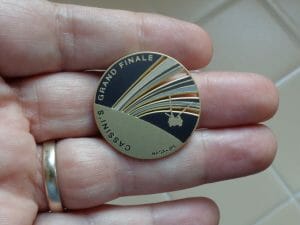
I traveled to southern California for the End of Mission of the Cassini spacecraft, which has been orbiting Saturn since 2004. Now, I’m not going to give you an exhaustive list of the Cassini mission’s accomplishments, as amazing as those are: if you want that, just about every science-related publication or TV program or web site can pile a ton of data and gorgeous photos on you. I’m not going to try to compete on their turf even if I did start my career as a science writer. Instead, I’m going to tell you some behind the scenes stuff in hopes that you’ll see a much bigger picture.
Unless you’re driving or something as you listen to this, you might want to pull up the Show Page for this episode since I’ll refer to a few things there. That page is thisistrue.com/podcast3
When Cassini was being built at NASA’s Jet Propulsion Laboratory, every few weeks I’d use some of my lunch hour to walk down to the gallery overlooking the clean room to watch the techs working on integrating all the scientific instruments into Cassini before launch. It took years, since it was a big and very complex spacecraft: 6.8 meters high, 4 meters wide — or 22 by 13 feet. It held 12 science instruments. Not just the obvious cameras, but a magnetometer to measure magnetic fields; imaging radar; multiple kinds of spectrometers to learn the composition of things like plasma, Saturn’s rings, and ions; a cosmic dust analyzer; and more.
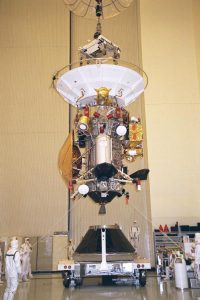
The resulting package — the spacecraft — was huge! I took a lot of photos during my visits, which are in a box …somewhere. But the official photographers could be in the clean room once they dressed up in those bunny suits, so I’ll put a JPL photo on the Show Page so you can see just how big the thing was. All together, with fuel, it weighed 5,600 kg, or 12,300 lb. — more than six tons. So it’s pretty much bigger and heavier than a fully loaded commercial delivery van.
And that loaded van was launched on October 15, 1997, about 15 months after I left JPL to work on This is True full time. Saturn, depending on where it is in its orbit, is about 1.2 to 1.7 billion kilometers away from Earth, or about 746 million to a little over a billion miles. The neat thing is, to get there, they didn’t point the rocket at Saturn. Instead, they pointed it at Venus, pretty much the exact wrong direction. Why? Not because the men on the team were afraid to ask directions. Rather, it was because Cassini was so big and heavy, we didn’t have a big enough rocket to get it to Saturn. By looping it around Venus, they could get a gravity slingshot effect — a boost to get it up to a higher speed so it could get all the way there.
You can see the complicated path in a diagram on the Show Page, because it’s actually a lot more complicated than that: after its launch on October 15, and its Venus flyby on April 26 the next year, Cassini looped around and got a second gravity assist from Venus on June 24 of the year after that. Then two months later, it zoomed by Earth and got a third boost. It skimmed by us at only 720 miles above the Earth’s surface, diving deep into our planet’s gravity well to get up to speed. But think about this: 720 miles is well inside the orbit of communications satellites! So after flying for almost two years, and more than a billion miles, it was still only 720 miles from Earth. But now it was going pretty darned fast, and could get to Saturn.
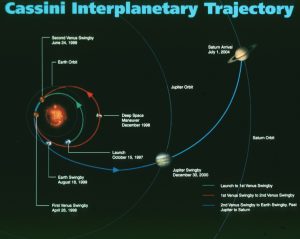
But first, one more step: after flying by Earth it went by the gas giant Jupiter on December 30, 2000, for yet another boost, and then, finally, Cassini arrived at Saturn three and a half years later, on July 1, 2004. In all, more than six and a half years after launch. It flew what’s called a VVEJGA trajectory — Venus-Venus-Earth-Jupiter Gravity Assist: VVEJGA. By using these gravity boosts it didn’t just get there, but by not using its fuel to get speed, it could reserve that fuel so it could move around Saturn and its moons to collect the most science data possible once it got there. And by the way yes: a planet’s gravity can also be used to slow a spacecraft down when it arrives, so it doesn’t just go shooting by.
So here’s what I find totally mind-boggling about all of this: you can’t just point a spacecraft at any old planet and figure it’s going to get flung out in the direction you want it to go. You have to first figure out where the planets are going to be when the spacecraft gets there, and aim the spacecraft exactly correctly so that the planet’s gravity will pull it in, thereby speeding it up into the right direction, rather than pull it in and pound it into its surface and making a pretty crater. And you have to know precisely not just what direction it will go, but at what speed when it’s flung out the other side. Just pause for a moment to consider the thinking involved behind that. Not just the concept that it can be done in the first place, but how to do it, and do it right. And remember that all the planets aren’t just sitting there: they’re all in orbit around the sun — they’re moving targets! And we have to figure out how to swing by, get flung out behind that target rather than crashing into it, and zoom into space toward where we know the next target will be …often years later!
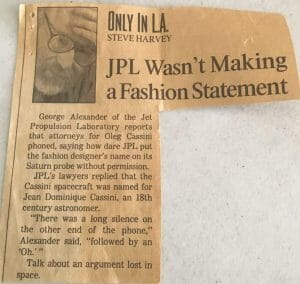
And the whole time, as the spacecraft is speeding out toward its destination, in this case Saturn, what’s happening? It’s slowing down because it’s being pulled on by the gigantic gravity of the sun, which is more massive than all the planets combined. Which, of course, also has to be taken into account — in advance, because that changes when the spacecraft will get to the next destination for the next gravity boost.
And here you thought high school algebra was hard. Well, at least I did: and that’s why I’m a writer and not a scientist!
I’m putting a really neat chart on the Show Page that shows how the spacecraft sped up going toward Venus (and the nearby sun), and slowed down after it went by, sped up as it got another gravity assist, and went slower, and slower, and slower as it was pulled on by the sun during its long journey until WHOOSH! it was captured by Saturn’s gravity — its “orbital insertion” where it went into orbit around Saturn, and then how it was pushed and pulled as it moved around there. It’s years of fascinating data condensed into one little chart that shows the whole path to Saturn in a fascinating way.

Did I say “mind-boggling”? But this is what Uncommon Sense gets us: more knowledge to move humanity forward. And as we saw not just with Cassini but with many other missions, they usually do get there, usually within seconds of what the plans called for. And those plans were all put into place in advance by brilliant men and women, white, black, Asian, Latino, and other, Americans and citizens of many other nations, who work together, and together understand how all of this works. And why? Not just to get there: the trip isn’t the thing. The spacecraft doesn’t just need to get there, it and its scientific instruments have to survive the journey. Its instruments baked by intense heat when it’s near the sun, and frozen by the cold of space a billion miles away from the sun. Think about that: can you put your computer into a standby mode for seven years, and then say Wake Up! Time to do intense work for 13 years?! Yeah, mine wouldn’t either.
Cassini’s mission at Saturn started July 1, 2004, and now here we are at the end, on September 15, 2017. Its computers still worked. Its radio transmitters still worked. Its cameras still worked. And all those systems and more have been working together to get photos and data back to Earth twenty years after launch — and remember, all of those parts had to be purchased years before that to be tested, assembled into components, and integrated into the spacecraft. With few exceptions, its parts have been working for 30 years now without any possibility that we can send a technician to fix anything that might fail.
In other words, the whole mission is running on 1980s technology. And for the most part, working perfectly.
But wait: there’s more.
Cassini was not just the first probe to go into orbit around Saturn to get a long and detailed look at that planet and its moons: it also carried Huygens — a lander that was dropped onto Titan, Saturn’s largest moon. It was named for the Dutch astronomer Christiaan Huygens, who discovered the moon in 1655. Titan is so large, it’s bigger than the planet Mercury — and it has an atmosphere. And not just an atmosphere, but one so thick that spacecraft can’t see through it with anything but radar. And oceans or lakes filled with liquid hydrocarbons, such as ethane and methane.
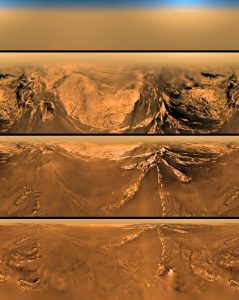
But hey: they can land a probe there for a closeup look around, and Cassini could relay its pictures and measurements of what it found. It could, and it did. And the project planners had to figure out how to do that, too. It was the first time we landed something on a moon other than our own. They thought it would only survive for a maximum of 30 minutes after landing, so it was designed to get and relay most of its data on the way down to the surface. But it actually survived on the surface for about an hour and a half, and sent more information than even hoped for. I’ll include a photo Huygens took from Titan on the Show Page too.
And, again, you can go to just about any science site, or JPL itself, to get all sorts of information on what Cassini and Huygens found: I’ll link to the JPL Cassini site on the Show Page. I am, though, putting one picture Cassini took on the Show Page, since it’s absolutely astounding, as well as help put things into perspective. At one point, the controllers at JPL realized they had a good opportunity when Cassini was behind Saturn’s rings: Earth would be visible through the gap in the rings, known as the Cassini Divison. That gap, and then the spacecraft, was named after the 15th Century Italian astronomer Giovanni Cassini, who first saw the gap in the rings with his crude telescope.
The controllers had the spacecraft take that picture to show Earth, way in the distance, in the rings’ gap. When they got it downloaded, they noticed a tiny speck off to the side. What the heck IS that? Then they realized that the photo also shows our own moon — they didn’t think Cassini would be able to see that. But it did, and that’s how good its camera was: even better than what its designers thought it could do.
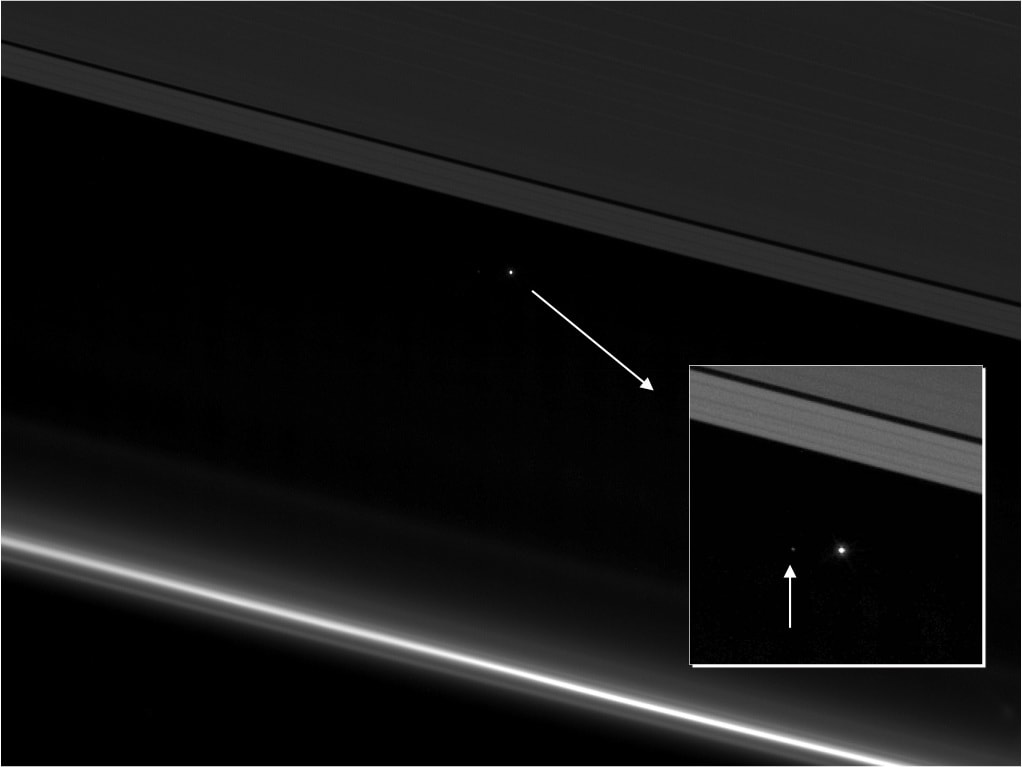
And let me give you one little tidbit to show you just how clever the mission planners were, even on the fly. You’ve probably heard why Cassini was deliberately flown into Saturn’s atmosphere this morning to burn it up. Since mission launch, they’ve realized that two of Saturn’s moons, Enceladus and Titan, might have the conditions to host life — or at least have what they call “prebiotic” environments. In order to avoid the unlikely possibility of Cassini someday colliding with one of these moons, NASA chose to safely dispose of the spacecraft in the atmosphere of Saturn. This will ensure that Cassini cannot contaminate any habitat or potential life on those moons.
Yes, Cassini was built in a clean room, and it’s been in space for years, but they can’t be absolutely sure the spacecraft is completely, entirely, sterile. They don’t want there to be any possibility that we could accidentally introduce Earthly microbes into those moons by crashing the spacecraft there, even 10,000 years from now. So by running the spacecraft into Saturn’s atmosphere, they can be sure it will be fully incinerated.
In the leadup to the End of Mission, I sat in on a briefing by Trina Ray, one of the mission science planners who has worked most of her 28-year career on the Cassini mission and, she says, “Still loving it!” She noted that when Cassini arrived at Saturn, it had about 2,000 lbs of fuel. As it was doing its last orbits, it had 20 — plus or minus 10! The idea was to use the very last of its fuel keeping the spacecraft stable, with its radio antenna pointed at Earth so it can relay as much information as possible in its final minutes before the spacecraft tumbled out of control in Saturn’s atmosphere, ending the signal lock when Cassini can no longer point its antenna toward home.
As I was writing this all up for the podcast, something occurred to me: they destroyed Cassini so it couldn’t possibly hit Titan or Enceladus, perhaps contaminating them, but they landed Huygens on Titan. Wouldn’t that contaminate Titan? I wasn’t sure about the details on that, so I called Trina to ask. I caught her on her cell phone, on her way home to try to get some sleep. She said it’s a good question …and they anticipated that.
Well of course they did! Here’s the answer: if Cassini had crashed into Titan, it was so massive it wouldn’t have burned up completely, and that’s why they figured microbes inside could survive, and maybe contaminate the surface. Probes meant to land on a body are sterilized in one of two ways: either by alcohol, as in any medical environment, or with heat, as also used in medical environments, like baking surgical tools in an autoclave. So indeed Huygens was liberally bathed in alcohol, but they also baked it — on the way down to Titan!
It had a heat shield that kept it from getting burned up in the atmosphere during descent, but that didn’t keep it from getting pretty hot: they calculated that it would get plenty hot enough to kill any microbes through and through. And by the way, they had to design all the instruments it carried to survive that heat. Again, thinking guided by Uncommon Sense not only anticipated problems, but came up with solutions.
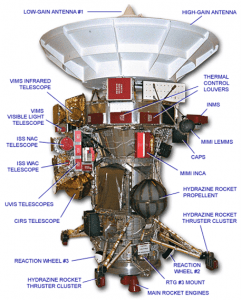
So again, Cassini’s End of Mission isn’t just about disposing of the spacecraft, it still performed science right to the end. Once they decided to destroy Cassini, Trina said in the briefing, they put out word to all the science teams: what do you want to do in the last orbits — orbits that will go inside Saturn’s rings, which is to say between the rings and Saturn itself? They wouldn’t fly the spacecraft inside the rings before, because it was too dangerous. Time to destroy the spacecraft? Well, what’s dangerous now? They went for broke, and came up with new science objectives for those last orbits. The scientists figured out what they could realistically get, and how many orbits it would to take to get that data. For instance, the magnetometer team wanted four orbits, Radio Science team wanted six orbits — and the antenna had to be pointed at Earth for those. And so on. The total to get it all: 36 orbits. The available number of orbits as the fuel was running out: 22.
So then they had to sit down and figure out what things could be done at the same time: could spectroscopy data collection co-exist with, say, radio astronomy experiments? They were able to plan it all out so everyone could get all the data they needed in the time they had.
Here’s one example that Trina told us about that, again, for me, was mind-boggling. One thing we wanted to learn all along about Saturn was details about its amazing and beautiful rings. To help scientists understand just how they work, how they stay so perfectly formed. To get that understanding, they need to know their mass — essentially, how heavy they are. They tried all sorts of things to get that measurement, especially of the thickest ring structure, known as the B ring. They tried to see through it with a camera, with the spacecraft on one side of the B ring and the bright sun on the other side; they thought they could figure out the mass by how much sunlight was filtered out. They know how bright the sun is, so if they could see, say, 5 percent of the sunlight coming through, they’d be able to do the math and figure out the ring’s mass. The problem: the B ring filtered out 100 percent of the sunlight, so they couldn’t do the math.
So they tried the same thing, except sending a radio signal between Earth and the spacecraft through the B ring. It’s the same idea: what percentage of the radio signal got through? The answer: zero — again, no way to do the math. But get this: by flying the spacecraft inside the rings, which remember was too dangerous to do before, they’ll be able to measure what the gravity pull is from the planet, and the gravity pull from the rings, and then they can do the math that lets them figure out the mass of the rings! That’s how sensitive Cassini’s instruments are: even being that close to the gigantic planet and its strong gravity, they’ll still be able to also see how much those thin rings are pulling on the spacecraft from the other direction, and get a decent measurement of the rings. That’s … just … astounding!
As Trina Ray put it in our conference, “There’s nothing better for a scientist to say than ‘I don’t know’!” It just means they have more work to do: more to learn. And they came up with another way — probably a foolproof way — to get the mass of the B ring at the last moment. It was because they were destroying the spacecraft that they were able to do something “dangerous” to get the knowledge they wanted.
And that’s why I love the contrast between my old job and my new job. I got to work with people who had the imagination and creativity to think of doing this stuff, and the ability to think about how to get the answers they want so they can understand how this universe is put together. We have the towering intellect of thinking scientists that’s like the gigantic mass of Saturn on one side, which really puts into perspective the other side, like a guy who wraps duct tape around his head after deciding that would be an effective disguise to help him get away with robbing a Kentucky liquor store.
This is True is thought-provoking entertainment, but what does that really mean? Yes, we’re entertained by the stories of people not thinking, but they also give us context about the human condition so that we can marvel on the fact that a species that includes the duct tape robber also includes the scientists that are figuring out the universe by putting their Uncommon Sense to good use.
And: in addition to the scientists thinking about putting technology to work, there are the engineers who figure out the technology that the scientists use. The exploration that JPL is doing wasn’t possible even just 50 years ago, when we were going to the moon using a computer whose memory board was a matrix of ferrite beads wrapped — by hand — with copper wire. They need the geeks too, to come up with the new technology to do the work.
And: before we could do this kind of exploration for real, before we had that technology available, there were flights of imagination by another kind of hero of mine: writers.
Just like Jupiter happened to be in a good position to help fling Cassini toward Saturn a little quicker, I also happened to be in town for a special meeting last night: the meeting of the oldest continuously operating science fiction club in the world, LASFS: the Los Angeles Science Fantasy Society, founded in 1934. What made this meeting special? I wanted to hear some the discussion about one of their recently deceased members, science fiction author Jerry Pournelle, who was the subject of this week’s Honorary Unsubscribe, which I’ll link to on the Show Page.
When the technology isn’t ready — or we’re not ready to spend the money to use the technology we do have — humans can still explore ideas using their own creativity. Before we went to the moon, we went there in stories, imagining what we might find. By exploring creative scenarios in stories and novels, we thought of ways to overcome obstacles. What if, for instance, the moon’s surface is several yards deep with loose dust, making a safe landing impossible? That was what some thought could happen, and there were contingencies put into place in case that did happen in 1969.
As David Gerrold, a science fiction writer, also a member of LASFS and also someone I met via the JPL Writers Club and have kept in touch with, he put it this way: “This is the primary function of science fiction — to be the Research and Development Division of the Human Species. This literature is the laboratory in which we consider the universe and our place in it. It is the place where we ask, ‘Who are we and what is our purpose here? What does it mean to be a human being?’” Brilliant!
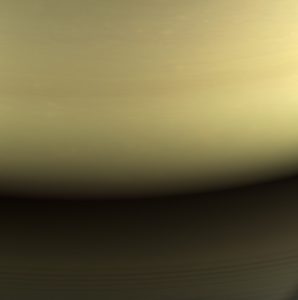
There are a lot of great minds in speculative fiction. Dr. Pournelle was one of them, and part of the reason he was this week’s Honorary Unsubscribe. But that “Dr.” title isn’t at all honorary, and it’s one of the reasons I say he had a great mind: Pournelle earned two doctorates, in psychology and political science. And a master’s, in experimental statistics and systems engineering; he also studied mathematics. After all that education, he worked in military strategy and aerospace before turning to fiction full time — all those interests informed his writing, making it more realistic and believable. Yeah: R&D for sure!
And if you talk to the scientists who are making it all happen in real life? Most will tell you that their imaginations were initially sparked by science fiction, from the golden age novelists to Star Trek and, more recently, shows like Babylon 5 and Firefly. Fiction sparks the imagination of the scientists, and their scientific discoveries spark the imaginations of the people creating the fiction. What a wonderful cycle, ever building and refining and moving all of us forward under the power … of pure thought. Think about that: they sure did. And what a wonderful example of Uncommon Sense at work, serving us all.
Again the Show Notes for this episode are at thisistrue.com/podcast3.
Thank you for listening to Uncommon Sense. If you’re not already a subscriber to the This is True email newsletter, think about signing up at thisistrue.com: basic subscriptions have always been free, because it’s about spurring humanity to think more, and react emotionally less.
I’m Randy Cassingham …and I’ll talk at you later.
Comments Note
Since this is a repost, comments start with those made on the original post — the dates are correct.
– – –
Bad link? Broken image? Other problem on this page? Use the Help button lower right, and thanks.
This page is an example of my style of “Thought-Provoking Entertainment”. This is True is an email newsletter that uses “weird news” as a vehicle to explore the human condition in an entertaining way. If that sounds good, click here to open a subscribe form.
To really support This is True, you’re invited to sign up for a subscription to the much-expanded “Premium” edition:
Q: Why would I want to pay more than the minimum rate?
A: To support the publication to help it thrive and stay online: this kind of support means less future need for price increases (and smaller increases when they do happen), which enables more people to upgrade. This option was requested by existing Premium subscribers.

Superb!!
Of course, launching the probe “in the exact wrong direction to get to Saturn” is just begging for the joke about how the *men* who launched didn’t ask for directions.
—
“I know what I’m doing.” -rc
Sad day, I knew cassini was coming to an end, but had no clue that Pournelle had passed away. I have been a long time fan of both him and Larry Niven. To this day I still use ‘One one hand xxxx. On the other hand yyyy. On the gripping hand zzzz’ when commenting on the web about various things. Some people recognize the reference and other ask WTF I am talking about ‘three hands? Dude are you stoned?’ etc. I then get to talk about a great work of fiction. He will truly be missed.
You are very lucky to have met such a brilliant and talented guy. Thanks for informing me of his passing, and kudos on a wonderful ‘unsubscribe’.
Karl’s comment (from Tujunga) is just hilarious! Thank you for that.
Randy, you keep proving time and time again what a wonderful writer you are. I always wonder how you could walk away from such a cool job. You are (were) literally a rocket scientist!! The go to job we use to describe somebody cool and able to deal with the most complex issues (next to brain surgeons).
But then you go and narrate with such emotion and I am almost brought to tears by the pure awe of how cool everything you shared in this podcast. From the gravity slingshots to Cassini’s last hurrah… Thank you for such a wonderful story.
—
Glad you enjoyed it, Adrian. JPL certainly was an interesting place to work, and I enjoyed it immensely. But I felt the calling to do something different, and accepted that challenge. My new career has also been very satisfying. -rc
Thank-you Randy! Again, well presented food for thought.
This was an excellent podcast – your best, so far at least. I do enjoy the banter between you and your assistant, but this episode with just you alone is better. Your amazement, emotion and wonder all come through brilliantly and you make it easy for us non-scientists to follow easily. I’ve been a Sci-Fi fan for a long time (I started with the Foundation Trilogy), and have continued to enjoy it while watching the science news follow along behind. Thanks.
—
I’ve read most of Asimov’s fiction: great stuff, including Foundation (which he added to, so the trilogy eventually became a heptalogy). But my favorite Asimov is actually a short story, not a novel: The Last Question. Sheer brilliance. -rc
I knew the Foundation Trilogy was 5 volumes, I somehow missed the two prequels. I’m gonna fix that pretty shortly! (Feeling thankful for library cards!) I do recall “The Last Question’. It is brilliant. Nightfall was my favorite (not-so-short) story. But truly, I don’t recall reading anything of Asimov’s that I didn’t love, including the Black Widows stories.
If we introduced “life” into one of the moons what is the fear of doing so? That in a few years it will sprout intelligent life that will send bad things our way? We hear the term contaminate, is this not our universe to play with? One might think that we would WANT to introduce life to the planets. We would want to spread our DNA beyond the small rock we are on. Was the concern that a tech with a sense of humor left a booger on it?
The question becomes is what is the worst case scenario that they are trying to prevent?
Like the bigger picture view of all of this. Being able to tie it all back to a Honorary Unsubscribe and the role fiction has played in our current exploration helps remind us how we got to where we are today.
—
It is a valid question. Is the universe ours? Science doesn’t think so — and I agree with them. It is supreme arrogance to assume we’re alone in the universe, and that if not, we’re the top of the heap. Both are extremely unlikely. To have a little humility and respect for what else is surely out there is prudent. For a fictional tie-in, it’s certainly the “Prime Directive” in action at a very fundamental level. That said, I’m all for colonizing Mars ASAP. I think humanity is “special” and needs a second foundation as insurance that we survive our petty base instincts, like fighting each other to the death because “they” don’t believe in the same myths that “we” do. -rc
“Worst case scenario” is that we kill off the Titanian life with our germs before we get a chance to even find if it exists — a la “War of the Worlds” the other way around.
I was a MidAmeriCon (Worldcon 1976), when Viking landed on Mars — and Jerry Pournelle set up a “viewing party”. Well, actually, it was a “Jerry gets on the phone to JPL and repeats the CapCom patter to the whole room” party. Annoyed the heck out of me that when I raced back to my hotel room to turn on the TV, absolutely none of the channels (all 4 of them!) had any mention of it.
—
“The media” constantly underestimates the public appetite for space news. -rc
Magnificent! There’s really no other word for it. That applies to the podcast & *especially* to the story behind the mission & all the insider details you provided.
You mention the moon landing and SciFi’s predictions of the mission. Personally I find it mind-blowingly incredible that SciFi writers *accurately* predicted everything about the Apollo 11 mission, *EXCEPT* that we’d be watching it on live TV (at least as far as I know). That was presumably too far-out even for *them*!
—
Heh! Yeah, they didn’t seem to anticipate the social reaction. The world pretty much stopped to watch. -rc
Thanks for this in-depth look at a truly great accomplishment, Randy ~ hope you continue telling us about all this, the way Carl Sagan did with Cosmos.
The space program, to me, has always been the greatest display of the best in humankind. I was already reading science fiction back in grade school and I knew where we had to go. Just had to.
I didn’t realize how disconnected most people were until the first space shuttle launch. My best friend, a fighter pilot, who was getting his degree in electrical engineering to go for the astronaut corps, and I cut class … twice … to watch the launch on the big screen in the cafeteria. After it had dwindled beyond the power of cameras to see, I looked around and realized that less than 10% of the people there had been paying any attention to it. When we went down a few days later to watch the landing, even fewer were paying any attention.
Maybe we were just enough older than most of the students that we remembered the days when that countdown was new and each launch was met with the fervent wish, instead of certainty, that they made it up and then back down again in safety.
When Challenger blew, everyone at work was saying how no one could ever get them into something like that … in a naval engineering department no less. When I said “If they asked me to go on another flight the very next day, my only reply would be ‘Where’s the ticket?'” they gave me the strangest looks, and most of those people were my age and older.
Are we really that few and far between, even now? When the next words after “I don’t know,” are “Let’s find out”?
Cassini and the Mars rovers and Rosetta and their brethren are those questions and the attempts to answer them made material. We’ve got to get to Mars, whether it’s run by NASA or Elon Musk. Luna City should have been built years ago and the ISS should not still be alone up there and so small. Maybe we’re the Vikings of space. First Europeans to get to the “New” world, but then never doing anything with it. Waiting until some other society actually makes a go of it.
I envy you your years with JPL and it’s obvious you loved them too, even if something that pulled you more strongly came along. Thank you for this podcast and sharing it with us.
—
When NASA was set up, it was part of their charter to explain things to the public. I don’t know what happened to that part of the mission. To me, it’s all still amazing to see what they can figure out. It’s sad that so many don’t have any curiosity about it, but NASA reports an amazing number of hits on their web sites when something is going on, so there is certainly a good segment of the population that wants to know more, and in that I feel hope. -rc
I think Doug needs to consider the contamination possibility from a perspective of biological diversity. If we were to contaminate one of the moons that are possibly (or possibly will) harbor life, we will alter the course of evolution on that moon. What benefit would we gain to screw up how one of Saturn’s moons develops? We’re not talking about a Goldilock’s planet (or even the Moon or Mars) where we might have the potential for colonization. The environment on a celestial body like Titan is inimical to human life in every way. There is nothing positive that comes from such contamination. However, to leave it alone and watch what happens not only is more interesting, it has the potential to let us gain insight into things like how life might have begun on Earth. At worst, leaving it alone is neutral. At best, it’ll give us really cool stuff to research eventually.
—
An excellent expansion of my point. -rc
Excellent work, as always. On the topic of colonizing Mars, ins’t there lots and lots of uninhabitable land right here on this planet that we could work on making habitable without the long commute? Isn’t Mars already a much less welcoming environment than what we are worried Earth will become. Seems to me that colonizing the Sahara or the Gobi desert would be a lot less work. Am I missing something?
—
It’s not about needing more room, it’s about needing a backup. Just as a hard disk crash could wipe out your work, the pictures of your children, and the draft of the novel you’ve been working on — so it’s smart to have a backup! — humanity needs a backup in case of, say, nuclear war, a comet slamming us, or many other scenarios. Humans have a lot of potential …and there’s no backup. -rc
Your point is taken. Anyway, back to work on my novel …. what? File not found?!?!
And there may have been a more romantic side to the story… https://medium.com/slackjaw/lost-letters-from-cassini-866ae51eec64
—
A lovely and inventive romance to be sure. Thanks — hadn’t seen that! -rc
I re-read The Last Question by Asimov just now after reading your comment on it. Man, how quaint the idea of talking to a supercomputer that has solved the problem of harnessing 100% of the sun’s energy on a teletype.
Anyway, yay, Cassini & the uncommon sense that went in behind it.
—
Well, consider ‘The Last Question’ was first published in 1956 — 62 years ago! -rc
I think it was Asimov who said all basic science starts with “That’s funny….”
Great podcast!
I just finished the book “Rocket Men” about Apollo 8 over Christmas 1968 when it orbited the Moon. I was 11, and listened to their broadcast, reading the first part of Genesis. I had followed the mission — what self-aware SF fan could not? I cannot recommend the book enough — it really captured the history and the people involved. Everybody involved — the engineers, astronauts, support staff, truly had the Right Stuff. Instead of a year — the normal planning cycle, they did it in 4 months. The mission itself was planned in an afternoon, by the folks who really knew how to do it. No bureaucrats, politicians, or those with other agendas. During the entire process, they were aware and calculated the risks, and lessons learned. Some of these lessons were bitter — including the Apollo 1 fire, when three astronauts, Gus Grissom, Ed White, Roger B. Chaffee, died horrible deaths. But great ventures require the willingness of risk and death. This is not to make light of the toll on the other astronauts *and their families*.
Cassini is an example of what and why we should do these things. We learned a tremendous amount of science and engineering from that mission. It was a worthy project for scientists and engineers to spend a substantial amount of their careers and lives on. They changed the world. And it is an example of the kinds of things that is a fantastic investment of our tax money. That investment, in both the knowledge from the mission itself, and the new engineering that had to be created, will affect generations to come. What a legacy!